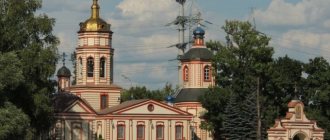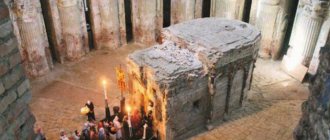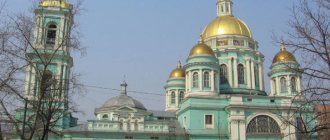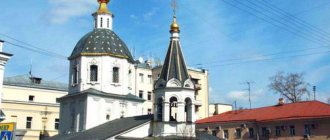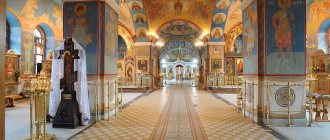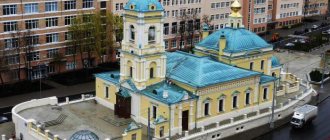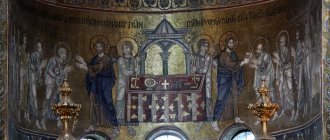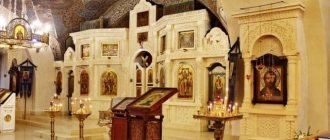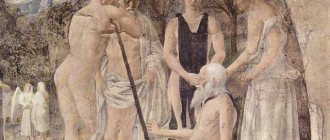Address: Mira Avenue, 19
Opening hours: daily, 7:00–19:30
If you walk from the Colonnade down Mira Avenue, you can easily reach the main cathedral of Kislovodsk - St. Nicholas Cathedral.
The very first one-story wooden church dedicated to St. Nicholas the Wonderworker
, appeared in the city in 1803 near the Narzan spring on the territory of the Russian military fortress. And there was only one priest and one psalm-reader, and on holidays a choir of garrison soldiers sounded here. Subsequently, the homes of soldiers who completed their service appeared near the Steel Fortress, and new houses were also built here for vacationers coming to the sources of the Acidic Waters, and the Kislovodskaya Sloboda was gradually formed. The need arose to build a more spacious temple.
The Commander-in-Chief of the Caucasian troops, General A.P. Ermolov, asked the main architects of the Caucasian Mineral Waters - the Bernardazzi brothers
-to make a project for a new church, which was erected in the second half of the 20s of the 19th century on the banks of the Olkhovka River.
The new temple of St. Nicholas the Wonderworker
, also wooden, greatly decorated the Kislovodsk settlement.
Built without a single nail, it was cruciform and majestic, thanks to two hipped domes - one on the church, the other on the bell tower. The grayish tones in which the church was painted made it stand out against the background of greenery. This St. Nicholas Church
, but the number of worshipers grew, and again the question of creating a new, already stone church arose.
In 1883, the Caucasian Spiritual Consistory gave permission for the construction of a stone five-domed St. Nicholas Cathedral on the main Slobodskaya square. The collection of donations has begun. Funds came from local philanthropists and from grateful Muscovites and St. Petersburg residents who once underwent treatment courses here. Kislovodsk entrepreneurs began the production of bricks from local clay for the upcoming construction, the trustee of which was the Cossack general I.I. Safonov
, the father of the future musician V.I. Safonov, whose name is now borne by the State Philharmonic of Kislovodsk.
During the construction of the temple, figured brickwork was used, which was then plastered with light cement, which gave the walls (especially among the greenery of the park) an almost white color. The temple was called the “ white cathedral”
" The three-altar, five-domed white-stone St. Nicholas Cathedral was consecrated in the year of the 900th anniversary of the Baptism of Rus' (1988) on the day of the icon of the Kazan Mother of God (November 4).
The erected temple was solemnly beautiful inside too. Wooden iconostases covered with carvings and gilding, powerful candlesticks, icon cases, banners - everything created a solemn mood. And the interior painting of the cathedral could be the envy of many churches, for it was carried out by famous artists - Yaroshenko and Nesterov, the brothers Vasnetsov and Polenov. And in the cathedral they sang Chaliapin
and Sobolev.
At the very beginning of the 20th century, a five-tier bell tower stylized as it was installed near the cathedral. The fourth and fifth tiers were open, on the fourth there were 8 bells, and on the fifth it was planned to hang one large bell, but this was never implemented. The cathedral and bell tower were surrounded by a magnificent church garden. Later, Cathedral Square was organized in front of the cathedral, and a Necropolis arose, within the fence of which many clergy found eternal shelter. The artist N.A. Yaroshenko, whose museum-estate is located very nearby, and the musician V.I. Safonov, whose name the Kislovodsk Philharmonic now bears, found eternal peace here.
In the 30s, the new Soviet government closed St. Nicholas Cathedral, and on September 1, 1936, it was simply blown up. On the site of the temple a square with a monument to Lenin appeared, Cathedral Square began to be called Red Square. So more than half a century passed until the time came for the restoration of the temples.
The cathedral that we can see now was recreated in the 90s of the last century from photographs of the destroyed temple. It was painted inside by a local artel of artists. An Orthodox gymnasium was opened at the cathedral, at the entrance to which a monument to Sergius of Radonezh
. The revival of the temple proceeded in stages and lasted for several years. But through labors and prayers, the temple seemed to rise from the ashes and now it stands - majestic and beautiful - St. Nicholas Orthodox Cathedral in the city of Kislovodsk.
To help pilgrims and visitors
Public minibuses with numbers 8,15,17 and buses 104,104 G go to the stop of St. Nicholas Cathedral.
The address of St. Nicholas Main Cathedral is the city of Kislovodsk, Mira Avenue, 19.
Every day the morning service begins at 7.30, and the evening service at 17.00.
Advice! On Tuesdays, all pregnant women are invited to prayer services at 15.00, during which prayers and petitions are sent to Heaven for the safe arrival of a new person in this world and for the protection of the mother during pregnancy and childbirth.
At the end of the service on Wednesdays, an akathist to St. Nicholas is read.
Every Saturday, all those present are invited to the “Inexhaustible Chalice” icon, in front of which a prayer service is performed with the reading of the akathist to the Most Holy Mother of God.
Those wishing to receive the Sacrament of baptism, which is performed in the lower church, take communion or enter into a church marriage, must discuss the time in advance.
St. Nicholas Cathedral of Kislovodsk
Schedule of services
Morning and evening services are held daily in the Cathedral of St. Nicholas the Wonderworker:
- Liturgy - at 07:30 (weekdays), at 06:00 and 09:00 (Sunday);
- Evening service - at 17:00.
Every Tuesday at 15:00 prayers are held for the successful resolution of childbirth and the successful course of pregnancy. Every week on Saturdays at 15:00, prayers with an akathist to the Most Holy Theotokos are held in front of the “Inexhaustible Chalice” icon. On Wednesdays, the evening service is supplemented by an akathist to St. Nicholas the Wonderworker.
Central iconostasis and chandelier, © Vladimir Emelyanov
Schedule of services in St. Nicholas Cathedral in Kislovodsk
Cathedral architecture
The architectural appearance of the cathedral contains features of several styles of church architecture, while it is in perfect harmony with the surrounding urban development and mountain landscape.
The revived St. Nicholas Cathedral inherits all the main features of its predecessor temple with the exception of the bell tower. In plan, its tall building has the same cruciform shape, which is complemented by three protruding apses of the altar.
The main volume of the temple is completed by five helmet-shaped domes, which are mounted on high light drums, shaped like lanterns. The largest and highest of them is the central one, two pairs of corner heads are lower and smaller in diameter. Two of them house bell towers. The domes of the five-domed building are topped with crosses of the same size.
The facades of St. Nicholas Cathedral are characterized by an arched shape: it is this that gives the building a certain lightness and visual aspiration upward, towards the heavens. This impression is reinforced by some horizontal elements of the cathedral's architecture, and especially the semi-circular windows.
Architecture of the main temple of Kislovodsk
In plan, the majestic building has a cruciform shape, complemented by three apses protruding from the sides. Five domes mounted on skylights rise above it. The middle one is larger and taller, the four corner ones are smaller in diameter and lower. The massive metre-thick walls rest on a huge concrete slab supported by a group of piles.
The arched shape of the facades gives the cathedral a certain lightness; semi-circular windows and horizontally located architectural elements visually direct the building upward. The composition is completed by tall skylights topped with helmet-shaped domes with crosses identical in style and size.
- The height of the cathedral is 54 meters.
- The total weight of the structure is 18,000 tons.
- Capacity - 3500 parishioners.
© Vladimir Emelyanov
The 10th anniversary of the consecration of St. Nicholas Cathedral was celebrated in Kislovodsk
Published 23.05.2018 13:55 |
Rating: / 2
On May 22, 2021, on the day of the transfer of the holy relics of St. Nicholas the Wonderworker, the memory of the heavenly patron of the temple and the Orthodox gymnasium was honored in Kislovodsk.
The celebrations began in St. Nicholas Cathedral, where a prayer service and a festive Divine Liturgy were performed. The service was led by the rector of the cathedral, Archpriest John of Znamensky.
On the 10th anniversary of the consecration of the cathedral, regular parishioners of the temple, guests of the resort city, teachers and students of the Orthodox St. Nicholas Classical Gymnasium gathered to honor the memory of St. Nicholas on the 10th anniversary of the consecration of the cathedral.
The chants of the Divine Liturgy were performed by the high school students celebrating the day of the school's patron saint and the cathedral choir. All students received Holy Communion.
After reading the Gospel, Father John conveyed the blessing of His Eminence Theophylact, Archbishop of Pyatigorsk and Circassia, congratulated everyone on the patronal holiday and addressed those present with a sermon, in which he drew attention to the ascetic life of the Saint, to the example of firm faith that we need in everyday life. called on everyone to keep the grace of God in their hearts and imitate St. Nicholas in love for God and neighbor. At the end of the Divine Liturgy, a traditional religious procession took place
Father John, having sprinkled holy water on the participants of the festive procession, once again congratulated everyone on the holiday and invited them to the cathedral square, where the guests were able to taste dishes prepared in the field kitchen organized by the Kislovodsk Cossacks. Over fragrant tea and pies, everyone could chat and rejoice at the temple’s anniversary
At the end of the Divine Liturgy, a traditional religious procession took place. Father John, having sprinkled holy water on the participants of the festive procession, once again congratulated everyone on the holiday and invited them to the cathedral square, where the guests were able to taste dishes prepared in the field kitchen organized by the Kislovodsk Cossacks. Over fragrant tea and pies, everyone could chat and rejoice at the temple’s anniversary.
The holiday continued at the evening service with the singing of an akathist to St. Nicholas the Wonderworker. The clergy of the Kislovodsk church district arrived to glorify the great saint and congratulate the rector on the anniversary patronal holiday. The confessor of the deanery, Archpriest Hermogen Limanov, on behalf of the clergy, congratulated Archpriest John on the patronal celebration, noting his contribution to the restoration of the cathedral.
In conclusion, Father John thanked Archbishop Theophylact for his attention and Archpastoral instructions, his brothers for the conciliar prayer, and the benefactors and trustees of the church for their constant care and material assistance to the parish. At the end of the service, all those praying in the temple were anointed with blessed oil, sprinkled with holy water and received as a gift the image of the patron of the temple
At the end of the service, all those praying in the temple were anointed with consecrated oil, sprinkled with holy water and received as a gift the image of the patron of the temple.
Save us, as our representative, great Nicholas!
Forward >
Divine service in St. Nicholas Cathedral
On May 22, on the day of remembrance of the transfer of the relics of Saint and Wonderworker Nicholas from Myra in Lycia to the city of Bari, Bishop Theophylact of Pyatigorsk and Circassia led a festive service in the St. Nicholas Cathedral in the city of Kislovodsk. The triumph of the patronal feast was enhanced by the anniversary date - twenty years ago the liturgical life of the cathedral community was resumed. This was followed by the reconstruction of the temple itself, which was destroyed during the years of anti-religious persecution.
Bishop Theophylact and the clergy, with a large crowd of people, celebrated the Divine Liturgy.
The service was attended by a representative of the Governor of the Stavropol Territory V.V. Kalugin, head of the resort city of Kislovodsk N.B. Lutsenko, Chairman of the City Duma S.G. Finenko, representatives of the administration, numerous guests and parishioners of the cathedral.
At the end of the Liturgy, a procession of the Cross took place around the cathedral, consecrating the source and the monument to St. Nicholas.
Addressing the believers, Bishop Theophylact recalled the Gospel reading of the day, dedicated to the meeting of the Lord with the Samaritan woman at Jacob's well. The bishop spoke about the inner change that occurred with the Samaritan woman who heard the Savior and deeply, with all her heart, accepted His words. So each of us, hurrying about our earthly affairs, can hear the Savior and open our hearts to Him, and drink from living water.
The Bishop congratulated everyone on the Patronal Day, the anniversary of the cathedral, thanked everyone who took and is taking part in the construction of the majestic temple, helps in painting, interior decoration of the cathedral, as well as those who are involved in teaching children in the Orthodox classical gymnasium and in helping the sick in the Orthodox charity clinic at St. Nicholas Cathedral in Kislovodsk.
A sign of this gratitude were the Bishop's certificates presented to the head of the city N.B. Lutsenko, doctors, teachers, builders and icon painters.
In her response, Natalya Borisovna heartily thanked Bishop Theophylact for assessing the activities of the city administration and donated a valuable gift to the temple.
From the history of the temple. The first temple in honor of St. Nicholas the Wonderworker was erected in the Kislovodsk fortress on the steep bank of the Olkhovka River in 1803.
With the emergence of the settlement, a wooden St. Nicholas Church was erected near the fortress according to the design of the Bernardazzi brothers in 1827.
Construction of the stone cathedral began in 1883 under the tutelage of the Cossack general I.I. Safonov, the father of the world famous musician V.I. Safonov.
On the 900th anniversary of the adoption of Christianity in Rus', on the feast of the Kazan Icon of the Mother of God on November 4, 1888, the white stone St. Nicholas Cathedral with dark blue domes and golden crosses was solemnly consecrated.
Famous Russian artists took part in the painting of the cathedral: the Vasnetsov brothers, V.D. Polenov, N.A. Yaroshenko, M.V. Nesterov. The voices of the great Russian singers F.I. Chaliapin and L.V. Sobinov sounded in the cathedral.
In 1900, a three-tier bell tower was built on the western side of the cathedral. In the fence of the cathedral there was a necropolis where clergy and laymen were buried, among which there were family graves - the crypts of the Safonovs and Yaroshenkos.
On September 1, 1936, the cathedral was blown up.
The history of the cathedral's revival began with the re-establishment of St. Nicholas parish on March 27, 1991. With the blessing of Metropolitan Gideon of Stavropol and Vladikavkaz, a temple was built in the building returned to the Church in honor of St. Nicholas the Wonderworker. Since August 14, 1991, regular services have been held in the church, and a Sunday school has been operating. Since September 1992, the Orthodox St. Nicholas Gymnasium has been opened at the St. Nicholas parish.
In 1994, by decree of the head of the administration of the Caucasian Mineral Waters, Alexei Viktorovich Kulakovsky, a Board of Trustees was created to ensure support for the Russian Orthodox Church in the Kavminvodsky deanery, whose assistance became the most significant contribution to the revival of the cathedral.
On May 20, 1997, large icons made using the enamel technique were placed on the facades of the cathedral, corresponding to the three altars of the cathedral: St. Nicholas the Wonderworker, the Holy Blessed Grand Duke Alexander Nevsky and St. Alexy, Metropolitan of Moscow. On the patronal feast of St. Nicholas the Wonderworker on May 22, 1997, the first Divine Liturgy was celebrated in the cathedral under construction, and on November 25 of the same year, three large bells were consecrated and installed in the belfry of St. Nicholas Cathedral. At the end of February 1999, the main dome of the cathedral with a cross was consecrated and erected (weight 8 tons, height 8 meters, diameter 10 m 60 cm). With the help of two tower cranes, the dome rose to a height of 42 meters, and the cross to its highest point - 54 meters, and shone over the city. In 2003, the fencing of the Cathedral was installed, with significant financial assistance in the construction of which was provided by the administration of the city of Kislovodsk. There are many revered icons in the Cathedral. One of the most revered shrines is the temple icon of St. Nicholas the Wonderworker, miraculously preserved during the destruction of the Cathedral in 1936. Currently, in the St. Nicholas Cathedral, the clergy - 4 priests and a deacon - perform regular daily services, and in the baptismal church dedicated to the Holy New Martyrs and Confessors of Russia - the Sacrament of Baptism and early Divine Liturgies. Since the revival of St. Nicholas parish, the rector of the church has been the mitered Archpriest John of Znamensky, Dean of the Orthodox Churches of the Caucasian Mineral Waters. Particularly solemn services are held on the days of the Patronal Feasts with the participation of parishioners and guests in the Procession of the Cross.
History of construction
In 1827, a wooden church arose on the site of the modern St. Nicholas Cathedral. The picturesque bank of the Olkhovka River was chosen as the site for its construction. The architect of the church project was D. Bernardazzi, and it was consecrated in honor of St. Nicholas the Wonderworker. The temple became a decoration of the city, painted in light colors, it stood out among the dark mountains and green city park.
Services were held in the church for about 50 years. During this period, the population of Kislovodsk increased significantly. On holidays, the wooden church could no longer accommodate all the parishioners, so the need arose to build a new, more spacious cathedral.
In 1883, a decision was made to build a new cathedral, but not a wooden one, but a stone one. Architect V.I. A project was developed in Grozman. The construction of the temple was supervised by engineer V.N. Anfinogenov. Construction of the white stone building was completed in 1888. The cathedral was made five-domed, paying tribute to ancient Russian architecture.
The consecration took place on November 4, 1888, timed to coincide with the celebration of the day of the Kazan Icon of the Mother of God. For those years, the church building turned out to be of impressive size, but the architect and builders managed to harmoniously fit its massive appearance into the landscape of the resort.
After 1917, the country began to struggle with religion. St. Nicholas Cathedral in Kislovodsk receives fewer and fewer parishioners, and in the 1930s the parish ceases to exist. In August 1936, local authorities decided to demolish the temple, and on September 1 it was blown up. Subsequently, a park was made on the site of the bombed cathedral, and a monument to V.I. was erected. Lenin. The square was renamed Red.
Revival of the shrine
In 1991, the history of the revival of the parish began. In April, the Holy Cross is installed at the construction site of the future temple. On September 12, 1993, the foundation stone was laid. The construction of the shrine took several years.
The walls of the cathedral are a meter thick; they were poured from monolithic concrete and lined with brick on the outside. By the summer of 1995, the height of the cathedral walls had already reached 15 meters. In 1996, the pace of construction slowed down as financing problems arose.
In the spring of 1997, the first festive service was held in the church, which was still under construction, and three icons were installed on the facades of the building, corresponding to the number of thrones in the cathedral. In the autumn of the same year, bells were installed on the belfry. In February 1999, a large central dome with a cross was installed.
In 2006, a cycle of work began on painting the interior of the cathedral. The icon painters faced titanic work that lasted 6 long years. Only in 2012 did they finish their work. In May 2008, while painting was still underway, the cathedral was consecrated.
Social work, everyday life
There is an Orthodox hospital attached to the temple. The hospital provides free medical care to everyone in need.
Reception is carried out by the following specialists:
- therapist;
- pediatrician;
- cardiologist;
- dentist;
- neurologist.
The hospital has its own charity service, whose workers take care of elderly lonely people, help them with food, and provide financial assistance.
In 2012, an Orthodox center for teenagers “Sretenie” was created at the temple. The main task of the center is to unite the Orthodox youth of Kislovodsk. The children study the Holy Scriptures, play sports, and go on tourist and pilgrimage trips.
All parishioners can visit the church history museum, which is located in the cathedral. The museum contains shrines from the former cathedral, ancient books and icons, church documents, and personal belongings of former church ministers.
Story
The first temple dedicated to St. Nicholas the Wonderworker appeared in Kislovodsk back in 1803. It was a wooden church on the territory of the fortress. The stone St. Nicholas Cathedral was built in 1883-1888. In 1900, a five-tier bell tower was built next to the church. Under Soviet rule, the building was blown up on September 1, 1936.
On March 28, 1991, St. Nicholas parish was recreated. In the building returned to the Church, a temple was rebuilt in the name of St. Nicholas the Wonderworker, which again became the center of the spiritual life of the city. Since August 14, 1991, regular services were held in the house St. Nicholas Church, and a Sunday school began operating.
Meanwhile, on April 14, 1991, in the city square, on the site of the destroyed cathedral, a cross was erected with an inscription about the upcoming reconstruction of the destroyed temple. Work to prepare for construction took two years. The cathedral project was developed by a group of designers led by architect V. B. Svintsitsky. Photographs of the old cathedral were used as the basis for the project.
On September 12, 1993, with a gathering of thousands of believers, the first stone was laid at the site of the restoration of the cathedral. A prayer service with the rite for the foundation of the cathedral was performed by Metropolitan Gideon of Stavropol and Bishop Athanasius of Perm, co-served by a large host of clergy. Representatives of the administration, Cossacks, Armenian and Georgian communities of the city took part in the service; Patriarch of Moscow and All Rus' Alexy conveyed a blessing in his message. To commemorate this event, a wooden cross, consecrated in 1998, was re-installed on Krestovaya Hill in the city.
Kislovodsk St. Nicholas Cathedral. The photo is no earlier than the 1930s.
Under the administration of Caucasian Mineral Waters, on August 19, 1994, a Board of Trustees was created to ensure the support and development of the Russian Orthodox Church in the region. The Chairman of the Board of Trustees, the head of the administration of Caucasian Mineral Waters, Alexei Viktorovich Kulakovsky, found funds for the construction of the cathedral and called on the leadership of resort cities to participate in the revival of Orthodox churches. By decision of the head of the city of Kislovodsk, V. G. Beketov, taxes were removed from the work performed. The association of heating networks laid 23 m of heating mains free of charge. The above-ground part was erected by the builders of SMU-17. However, in 1996 construction work began to slow down. Due to a lack of funds, initial plans to complete the work by 1998 had to be changed. Despite the fact that federal funding was stopped, construction did not stop.
On May 20, 1997, three large icons on copper plates using the enamel technique were installed on the facades of the temple, corresponding to the three altars of the cathedral: St. Nicholas the Wonderworker, Blessed Grand Duke Alexander Nevsky and St. Alexy, Metropolitan of Moscow. The election of the saints in whose name the chapels were consecrated was due to the fact that they are the heavenly patrons of the patriarch and metropolitan, who contributed to the revival of the cathedral. On the day of the patronal feast of May 22, 1997, for the first time since the beginning of the revival, the rector of the church, Archpriest John of Znamensky, performed a festive Divine Liturgy, followed by a crowded religious procession. On November 25, three large bells were consecrated and installed on the belfry, and on December 29 of the same year, the restored temple was crowned with the first dome. In 1999, on February 7, the first Divine Liturgy was celebrated in the lower church of the cathedral, consecrated in the name of the new martyrs and confessors of Russia. On February 25, Thursday of the first week of Lent, the main dome with a cross was erected on the temple; on May 22 of the same year, for the first time, City Day was timed to coincide with the patronal feast of the cathedral. Regular services in the upper church began on Easter 2000.
The construction of the cathedral fence was completed with the erection of the dome on the main gate on July 21, 2002. During the Great Lent of 2005, a team of artists under the leadership of N. M. Vdovkin completed the installation of the altar canopy, and at the beginning of 2006 Vdovkin began work on painting the altar. On December 3, 2006, the laying of granite floors was completed. In December 2007, the painting of the altar was completed and the solea fence of all three altars was installed. After the Nativity of Christ in 2008, painting of the under-dome part began.
On May 22, 2008, the great consecration of the cathedral took place. The rite was performed by Metropolitan Clement of Kaluga and Archbishop Feofan of Stavropol with a host of clergy in front of a gathering of thousands of believers. Patriarch of Moscow and All Rus' Alexy II sent a message to the participants of the celebrations.
Revival of St. Nicholas Cathedral
The reconstruction of the parish began in March 1991, and already in April the Holy Cross was erected on the site of the future religious building. The project was developed under the leadership of V. Svintsitsky for almost two years on the basis of surviving photographs of the majestic St. Cathedral, blown up in 1936. Nicholas the Wonderworker. The group of specialists was given the goal of realizing the architectural appearance of the former temple as accurately as possible, which was accomplished.
The first stone of the modern St. Nicholas Cathedral was laid in September 1993. A year later, under the administration of the Caucasus Mining Waters, a board of trustees was created, whose leadership actively took part in raising funds for construction and helped resolve economic issues. Sometimes the process of constructing the temple was slowed down, and therefore the completion deadlines were not met. The construction of the cathedral was completed only in February 1999, after the installation of the central dome and the cross crowning it.
St. Nicholas Cathedral of Kislovodsk, © Svetlana Tikhonova
Chronology of main events:
- May 20, 1997 - three main icons, made using the enamel technique on copper plates, were installed.
- May 22, 1997 - the first Divine Liturgy was held, as well as a festive religious procession.
- November 25, 1997 - the bells of the belfry were consecrated.
- December 29, 1997 - the first dome was erected.
- February 7, 1999 - the first Liturgy was celebrated in the lower church.
- Easter 2000 - regular services began.
- July 21, 2002 - a dome was erected over the arch of the main church gate.
- May 22, 2008 - the consecration of St. Nicholas Cathedral took place.
- 2012 - a cycle of work on painting the altar, walls, altar and dome spaces was completed.
Today St. Nicholas Cathedral is the center of the spiritual life of Kislovodsk and the settlements located near the city.
Orthodox gymnasium and monument to Sergius of Radonezh, © Anna Kudryavtseva
Social service
Working with drug addicts
In 2009, with the blessing of Bishop Theophan, Archbishop of Stavropol and Nevinomyssk, on the territory of the KMS, in Kislovodsk, at the Church of St. Nicholas, the first women's branch of the Spaso-Preobrazhensky Rehabilitation Center appeared.
Within the walls of the center, work is being carried out on the rehabilitation and prevention of addictions from drug addiction, alcoholism, gambling addiction, the resocialization of people, and the revival of their spiritual values.
The main stages of work: getting rid of the disease of drug addiction; spiritual and moral revival of the individual, revival of spiritual values; churching.
The center's students carry out preventive activities for young people, social events, and pickets aimed at preventing and stopping the development of drug addiction and alcoholism.
During the existence of the Orthodox women's rehabilitation center, 26 women of different ages underwent rehabilitation, more than half of whom returned to society as useful people. One of the pupils remained to work at the center, and 8 returned to normal life and started families. The branch in the city of Kislovodsk is designed for simultaneous accommodation of 10 novices. Currently, 6 people are undergoing rehabilitation.
The novices of the women's center struggle with their dangerous addictions by serving God and others, join the church, lead a socially useful lifestyle with the hope of returning to society as full-fledged citizens. Obedience in the temple is a task that each of the nuns performs with special care. The evening and morning rules are always performed in the center, the Bible and the Lives of the Holy Fathers of the Orthodox Church are studied. The girls also conduct preventive conversations with those who have decided to take the path of repentance and correction.
St. Nicholas Cathedral in Kislovodsk after the revolution
After the revolution, St. Nicholas Cathedral in Kislovodsk survived and remained active. For almost 15 years, services were held there, which gradually lost their regularity. This continued until 1936, when the authorities decided to erase this temple from the face of the earth.
St. Nicholas Church in Kislovodsk was blown up in early September 1936 by order of the Soviet administration. The beautiful temple was destroyed by a powerful explosion, to the great sadness of the Orthodox residents of Kislovodsk.
The history of the restoration and new life of St. Nicholas Cathedral begins with the collapse of the Soviet Union, positive changes in society in relation to Orthodoxy and the process of rebuilding St. Nicholas parish. The starting point of this good action is considered to be March 27, 1991. The church was given back the territory of the cathedral and the original brick building for the parish, which previously, in Soviet times, housed the city's Main Post Office.
It was decided to rebuild the temple in the name of St. Nicholas the Wonderworker. Archaeological excavations were carried out to determine the historical boundaries of the temple. It was decided to restore the cathedral to its former appearance, for which they undertook a search for old photographs in the Kislovodsk and federal archives. We managed to find several pre-revolutionary photographs, the images on which were taken as the basis when forming the project.
Used materials
- Page of the official website of the Kislovodsk deanery:
- Boglachev S. V., Savenko S. N., Architecture of old Kislovodsk
, Pyatigorsk: Snow, 2006, ch. “Temples of Kislovodsk,” section “St. Nicholas Church”:
- "Kislovodsk. St. Nicholas Cathedral,” website of the Sunday school of the St. Petersburg Resurrection Novodevichy Convent:
Paragraph according to the official website of the Kislovodsk deanery,
Paragraph according to the book. Boglachev S.V., Savenko S.N., Architecture of old Kislovodsk
, Pyatigorsk: Snow, 2006, ch. “Temples of Kislovodsk,” section “St. Nicholas Church,”
According to the official website of the Kislovodsk deanery,
Boglachev S.V., Savenko S.N., Architecture of old Kislovodsk
, Pyatigorsk: Snow, 2006, ch. “Temples of Kislovodsk,” section “St. Nicholas Church,” . An article on the page of the Kislovodsk deanery, indicates that the architects “used the sketches they created of the temples of the ancient Alans and their descriptions.”
Boglachev S.V., Savenko S.N., Architecture of old Kislovodsk
, Pyatigorsk: Snow, 2006, ch. “Temples of Kislovodsk,” section “St. Nicholas Church,” . The article on the page of the Kislovodsk Deanery, indicates the years of construction.
So according to the page of the Kislovodsk deanery,. Boglachev S.V., Savenko S.N., Architecture of old Kislovodsk
, Pyatigorsk: Snow, 2006, ch. “Temples of Kislovodsk,” section “St. Nicholas Church,” indicates that the temple “was a simple one-nave basilica with a gable roof and a high light dome.”
Version from the page of the official website of the Kislovodsk deanery,
Boglachev and Savenko suggest that Anfinogenov could also be the author of the temple project. Boglachev S.V., Savenko S.N., Architecture of old Kislovodsk
, Pyatigorsk: Snow, 2006, ch. “Temples of Kislovodsk,” section “St. Nicholas Church”,
So according to the book. Boglachev S.V., Savenko S.N., Architecture of old Kislovodsk
, Pyatigorsk: Snow, 2006, ch. “Temples of Kislovodsk,” section “St. Nicholas Church”,
According to the book Boglachev S.V., Savenko S.N., Architecture of old Kislovodsk
, Pyatigorsk: Snow, 2006, ch. “Temples of Kislovodsk,” section “St. Nicholas Church”,
Story
The construction of the temple began in 1905 on a high section of Rebrovaya Balka, on Pomerantsevaya Street. The temple was built with donations from parishioners and benefactors to the design of architect G.E. Volkov in an eclectic Russian style. The temple was a two-story, five-domed quadrangle with rich relief decoration made of red unplastered brick. The three-apsid temple had one altar. The center of the building was crowned by a large onion-shaped dome; above the refectory there was a similar one, but smaller. People called this church Shalyapinskaya, as they said that F.I. Shalyapin donated a large sum for its construction, and then often visited the temple during his visits to Kislovodsk. The church was also called Red, for the beauty of its architectural ensemble and the red color of the brickwork.
1912 is considered the year of the consecration of the new church. In December 1918, A.I. Solzhenitsyn was baptized here.
In the early 1930s, the domes were removed and services were stopped. In 1936-1937, a dormitory for recruited construction workers was built here, then a gym, and after its closure - a dormitory for a medical school.
In 1942 the temple was reopened. On April 9, 1965, at a meeting of the city executive committee of the Kislovodsk Council of Deputies, a decision was made to demolish the church, which was done the same year. In its place they built a dance floor and a boiler room, but they left everything, turning the holy place into a landfill. At the same time, believers still came here.
After the destruction of the church - the last in Kislovodsk - services were held in a small wooden barracks, given over to the church. The total area of the room was initially 10x10 m, then, with the permission of the city executive committee, the usable area was expanded by another 6 square meters. m. But the space remained very cramped and around 1975 permission was received to build a new church. However, instead of the location of the old Panteleimon Church, the site of another destroyed church, the Exaltation of the Cross Church (see below), was allocated for the new church, where the only city parish moved.
In 1994, on the day of remembrance of St. Panteleimon the Healer, a cross was erected on the site of the destroyed Panteleimon Church. The following year, a chapel was built, soon converted into a temple, in which the first prayer service was held on August 9, 1995.
In 1998, an independent parish was opened in which full-fledged parish life was resumed: statutory services, religious services, and Sunday school classes were held.
On July 14, 2002, the cornerstone was laid for the foundation of a new large parish church. In 2008, philanthropists from Voronezh donated 8 small bells and one large bell, weighing 2 tons, to the temple under construction. On January 14, 2012, Bishop Theophylact (Kuryanov) of Pyatigorsk performed the rite of consecration of the domes and crosses of the new church.
On June 6, 2021, Archbishop Theophylact, concelebrated by the clergy, consecrated the lower aisle of the Panteleimon Church under construction in honor of St. Blessed Xenia of St. Petersburg.
From the history of Kislovodsk. Church of the Exaltation of the Holy Cross
The history of the Church of the Exaltation of the Holy Cross (Cathedral of the Exaltation of the Holy Cross) goes back to the mid-19th century, when in 1825, north of the Kislovodskaya Sloboda and the Narzan spring, a Cossack village arose, founded by Zaporozhye and Don Cossacks who settled in the North Caucasus and defended the southern borders of Russia. They also erected a small church with a bell tower, consecrated in honor of the Exaltation of the Holy Cross.
The village grew, its population increased. In 1895, the society of the village of Kislovodsk petitioned His Eminence Vladimir, Bishop of Vladikavkaz and Mozdok, to expand the church and build a new, larger bell tower.
In 1896, the blessing was received and the collection of donations began. The collection book for the construction of the temple was issued in the name of the Cossack Eliazar Matveevich Nagorny and the peasant Evdokim Mikhailovich Dokukin. The work was supervised by parish priest Mikhail Lisitsyn. The reconstruction took quite a long time and was finally completed in 1906. However, during the years of Soviet atheism, the temple was destroyed.
In 1964, after the destruction of the Panteleimon Church in the city of Kislovodsk, church services were held in a small wooden barracks.
The building, given over to the church, housed school classrooms with a total area of 10x10 m. With the permission of the city executive committee, the usable area was expanded by another 6 square meters. meters. But over time, the number of parishioners increased, which required the construction of a more spacious church.
Construction permission was received after 10 years. Documents of the destroyed temple were not preserved, so it was decided to choose the type of temple traditional for Orthodox architecture. Construction was carried out under difficult conditions. However, despite the obstacles from the authorities, the construction was popular. Funds came from all over the country, everyone tried to put a brick into the walls of the new temple.
In the early 80s. In the 20th century, tourists from foreign countries were told that there was freedom of religion in the Soviet Union. In Germany, postal paper was issued with the imprint of a church being built in Kislovodsk. Nevertheless, the conflict between the authorities and believers became known abroad; the Voice of America broadcast about it. Soon the political situation in the country changed - US President Reagan was to visit Moscow, which contributed to the completion of the construction of the temple.
The Church of the Exaltation of the Cross took 11 months to erect. The temple was built and consecrated for the 1000th anniversary of the adoption of Christianity in Rus'. Construction was completed in 1988, and the grand consecration took place on October 4, 1988. The interior painting of the Church of the Exaltation of the Cross was completed in 1996. The painting was supervised by Moscow artist Nikolai Ivanovich Bureichenko.
The consecration of the temple took place in front of a large crowd of worshipers. The service, which was performed by Archbishop Anthony (Zavgorodniy) of Stavropol and Baku, was attended by the representative of the Patriarch of Antioch to the Patriarch of Moscow Archimandrite Niphon, the representative of the Patriarch of Bulgaria to the Patriarch of Moscow Archimandrite Gabriel, the rector of the Church of the Holy Equal-to-the-Apostles Mary Magdalene in Weimar Archpriest Alexy Parfenov and the clergy dioceses .
The first rector of the Church of the Exaltation of the Cross was one of the oldest priests of the Stavropol and Baku Metropolis, mitered Archpriest Sergius Limanov.
The Church of the Exaltation of the Holy Cross is a historical and cultural monument of regional significance.
The temple has three chapels - the main Cross and two side chapels - in honor of St. Nicholas the Wonderworker and in honor of the Great Martyr and Healer Panteleimon. In the temple there is a great shrine - the miraculous icon of the Mother of God “Quick to Hear”, painted by the Athonite monks.
Currently, on the territory of the temple there is a baptismal church in honor of the holy Equal-to-the-Apostles Tsar Constantine and Queen Helena.
St. Nicholas Cathedral in Kislovodsk: the story of a revival
In the Kislovodsk valley he rebelled among the mountains
The majestic and handsome St. Nicholas Cathedral.
Its domes glitter with gold,
Crosses go up into the sky like an arrow.
Victor Dubrov
St. Nicholas Cathedral of Kislovodsk today is the main temple of the Kislovodsk deanery. A classical gymnasium operates under it, an Orthodox hospital is open, and the “Shrines of the Native Land” museum welcomes visitors. But the history of the cathedral is sad: having experienced a time of unprecedented prosperity, it was completely destroyed. And only a few years ago, services and sacraments began to be held again in the revived temple.
St. Nicholas Cathedral of Kislovodsk: from a wooden garrison church to a white stone temple
As you know, the history of the city of Kislovodsk began in 1803, when, in accordance with the rescript of Alexander I, a fortress was founded at the Narzan spring. At the same time, the garrison St. Nicholas Church appeared here. According to one version, it was a modest one-story wooden building, services in it were performed by a single priest and were accompanied by a soldier’s choir. Another version says that services were then held in the house church at the infirmary or, in warmer times, in a spacious tent with a camp iconostasis.
The resort was actively developing, more and more travelers came to Kislovodsk to experience the magical power of local waters, the city's population grew, people needed a more spacious temple. General A.P. Ermolov, being at that time the commander-in-chief of the troops of the North Caucasus Line and actively engaged in the improvement of the region, decided to build a new church. For the project, he turned to the Bernardazzi brothers, architects from Lugano, Switzerland, who devoted their lives to the construction of buildings in Caucasian water resorts. A few years later, the steep bank of the Olkhovka River was decorated with a wooden church with a bell tower. For more than half a century it was the spiritual center of Kislovodsk.
As the years passed, representatives of many famous merchant and noble families settled in the city, and the parish expanded. The St. Nicholas Church building, designed for one hundred people, was again no longer enough to accommodate everyone at services. At first, they could not raise the required amount for the construction of the new cathedral, but over time, donations began to arrive from other Russian cities, in particular from Moscow and St. Petersburg. Grateful patients, who received invaluable help in the fight against serious illnesses on the waters, contributed to the improvement of the resort. The new white-stone St. Nicholas Cathedral was solemnly consecrated on October 22 (old style) 1888, the day of the Kazan Icon of the Mother of God.
The walls of St. Nicholas Cathedral in Kislovodsk were seen by many celebrities: it was painted by famous artists - M.V. Nesterov, V.D. Polenov, the Vasnetsov brothers, and at the services the voices of the incomparable M.V. Sobinov and F.I. Shalyapin. But the heyday of the cathedral was not destined to last long: in the 30s of the last century it was blown up, and its place was taken by a monument to V.I. Lenin.
St. Nicholas Cathedral in Kislovodsk: 21st century - the beginning of a new life
The history of the revival of St. Nicholas Cathedral is not simple. It took seventeen years to recreate the main Kislovodsk temple. The beginning of a long process was the formation of St. Nicholas Parish in March 1991. In April, a cross will be erected on the site of the future temple.
In September 1993, the first stone was laid in the foundation of the cathedral, and already in May 1997, the first festive liturgy took place within its walls. But there were still more than ten years left before the completion of the work, many works and significant dates:
- February 1999 - installation of the main dome with a cross;
— May 1999 – transfer of the holy relics of St. Nicholas the Wonderworker;
— 2002 – construction of a fence, consecration and erection of a dome on the main gate;
— 2006 – completion of laying granite floors;
— 2006-2007 – painting of the altar;
— 2008 – great consecration of St. Nicholas Cathedral.
Today, St. Nicholas Cathedral is not only one of the main decorations of Kislovodsk, but also the center of its spiritual life.
History of temples in the name of St. Nicholas the Wonderworker
The first mention of the St. Nicholas Church on Kislye Vody dates back to 1803. It is known that a long one-story building was erected from wood within the boundaries of the Kislovodsk fortress. There were no decorations outside or inside, only in the middle of the gable plank roof there was a tent topped with a cross. Divine services were then conducted by a single priest on holidays and Sundays, and the church choir consisted of soldiers.
The fame of the healing mineral spring Narzan quickly spread beyond the Caucasus. Year after year, more and more holidaymakers came here, so the need to build new houses around the fortress arose on its own. In addition, retired soldiers did not want to go home, considering this region their second homeland. Kislovodskaya Sloboda was growing, but entry to the garrison church was limited. In such a situation, the only solution was to build a new temple for local residents and visitors.
Night illumination, © Dmitry89
Parish Nicholas Church
In 1824, the Bernardazzi brothers, natives of Italian Switzerland, began designing a new Orthodox building. A few years earlier, they came to St. Petersburg to participate in the construction of St. Isaac's Cathedral. Soon Joseph Karlovich and Johann Karlovich found themselves in the Caucasus, and subsequently became the first architects of Kislovodsk and Pyatigorsk. General A. Ermolov, who in those years held the position of Commander-in-Chief of the North Caucasus Troops, approached Bernardazzi with a request to take up the project.
A new wooden church in the name of St. Nicholas the Wonderworker was built on the elevated bank of the Olkhovka River in the period 1825–27.
A special feature of the St. Nicholas Church was the absence of metal fasteners in the structure. At that time, nails and staples were not produced in the Caucasus, and it was too expensive to import them from afar. Therefore, it was necessary to assemble the crowns and roof with the help of axes and saws.
Bird's eye view of the main cathedral of Kislovodsk, © Muhammad Ortikov
In plan, the building had the shape of a cross, elongated towards the west. The inner surface of the walls was painted with white, which has a bluish tint. The decoration of the church consisted of a three-tiered iconostasis with gilded carvings, decorated with lush floral ornaments, and several small icons in frames hung on the walls. Wide window openings served as light sources during the daytime. In the evenings, candles were lit in the temple, placed in the chandelier and numerous lamps.
The facades of the wooden St. Nicholas Church, considered the adornment of the entire Kislovodsk settlement, were decorated with lace carvings. The central dome was an octagonal tent topped with a cross. The bell tower had a similar roof structure, but was smaller.
Stone Temple
The urgent need to expand the church appeared in the second half of the 19th century. The population of Kislovodsk grew, so the old temple could no longer accommodate everyone. Divine services were held in cramped conditions, some even had to stay on the street. Petitions for the construction of a new stone structure have been submitted to the highest religious authorities more than once since 1879. They were accompanied by plans and approximate estimates. Permission was received in 1883.
St. Nicholas Cathedral against the background of surrounding landscapes, © anderson2706
It is believed that the author of the project is the architect V. Grozmani. The construction was supervised by military engineer V. Afinogenov.
- The period of construction of the temple was 1883–88.
- Consecration of the white stone St. Nicholas Church - November 4, 1888
- Construction of a five-tier bell tower - 1900
- Obtaining the status of a cathedral - 1908.
- Closing in the early 1930s.
- Destruction - September 1, 1936
The stone three-altar St. Nicholas Cathedral had impressive dimensions, but outwardly it did not look like a heavy block. Several styles were present in its architectural appearance, but in general harmony was maintained with the resort development. The interior decoration consisted of three carved iconostases made of wood and covered with gilding, rich paintings created by famous Russian masters of that time, gilded vestibules over the altars and the altar, as well as various church utensils.
Parishioners of St. Nicholas Cathedral had the opportunity to hear the voices of the great Russian singers M. Sobinov and F. Chaliapin.
Near the church, a Cathedral Square and a necropolis appeared, where many respected citizens and prominent clergy were buried. After the temple was razed to the ground in the 30s of the last century, a square was laid out in its place, in the center of which a monument to V. Lenin was erected. The square was renamed Red Square.
View of the cathedral from Mira Avenue, © Anna Kudryavtseva
Architect, exterior decoration, architectural ensemble
Reconstruction of the modern cathedral began in 1993. The project of the new temple was developed by the architect V.B. Svintsitsky. Work on the creation of the project lasted for more than two years. The basis was taken from photographs of an old building destroyed by the Bolsheviks in the 30s.
The main task of the designers and builders was to accurately recreate the appearance of the former temple, and they coped with this. The structure retained its cruciform shape; three semicircular projections (apses) were attached to the sides. The facades of the cathedral are made in an arched form.
Three of them have large icons; they are painted in enamel on copper sheets. The icons correspond to the three thrones of the temple: Alexander Nevsky, Nicholas the Wonderworker, Metropolitan of Moscow St. Alexy.
The entire majestic composition of the cathedral was crowned with five domes. The middle dome was designed to be the tallest and largest in diameter. The final height of the structure was 54m, and the total weight of the entire structure was 18,000t. On major church holidays, the temple can accommodate up to 3,500 parishioners.
Inside the cathedral
The interior decoration of the St. Nicholas Cathedral in Kislovodsk has always made a great impression; its floors are lined with granite slabs; the temple can accommodate 3,500 pilgrims. This is facilitated by its internal design: the central dome of the temple rests not on four pillars, as can often be seen in other Orthodox churches, but on specially designed structures in the form of semi-arches.
The premises of the cathedral create excellent acoustics, for which the previous temple was famous. It is no coincidence that at one time, under the arches of the St. Nicholas Church, the voices of the great Russian vocal masters - Fyodor Chaliapin and Leonid Sobinov, were heard, singing along with the church choir of the cathedral.
Nowadays in the St. Nicholas Cathedral all three chapels are painted, and in the side chapels you can see paintings of scenes from the lives of the saints in whose honor they were consecrated. This, for example, is the foundation of the Moscow saint, Metropolitan Alexy Chudov monastery or the vision of the holy prince Alexander Nevsky of the passion-bearing princes Boris and Gleb on the eve of the historical battle with the Swedes.
The most revered icons of St. Nicholas Cathedral are located on both sides of the main iconostasis and placed in gilded icon cases. The baroque iconostasis in the pseudo-Russian style was created in 2010. The entire structure consists of four tiers and is also richly decorated with gilded openwork details, surrounded by a fine ligature of skillful wooden carvings that make up various ornaments in folklore traditions.
In each of the aisles there are two-tiered iconostases of similar shape. Solei are traditionally separated from other areas of the interior of the temple by decorative fences made of beautiful and graceful openwork lattices.
Interior decoration
There are three altars in the cathedral. The main one was consecrated in the name of St. Nicholas the Wonderworker, and the other two, side chapels, were consecrated in honor of Alexander Nevsky and the Metropolitan of Moscow, St. Alexy. The walls and ceilings are decorated with rich paintings. The floors are laid with granite slabs. The soles (raises in front of the altars) are separated from the general part of the temple by decorative gilded fences in the form of openwork grilles, which are the decoration of the cathedral.
In St. Nicholas Cathedral there is an icon of St. Nicholas the Wonderworker, revered by Orthodox believers, incredibly preserved after the barbaric destruction of the previous stone church.
Behind the main altar there is a cascading four-tiered iconostasis, decorated with openwork gilded elements. In the aisles there are two-tiered iconostases of similar shape.
The interior decoration of the temple amazes with its splendor. Today, Kislovodsk residents, holidaymakers and city guests come here with pleasure for peace, advice and support.
